Vegetarian Collard Greens
on Oct 02, 2023, Updated Jun 12, 2025
This post may contain affiliate links. Please read our disclosure policy.
The quintessential Southern vegetable staple, but with no meat! (Also, vegan!)
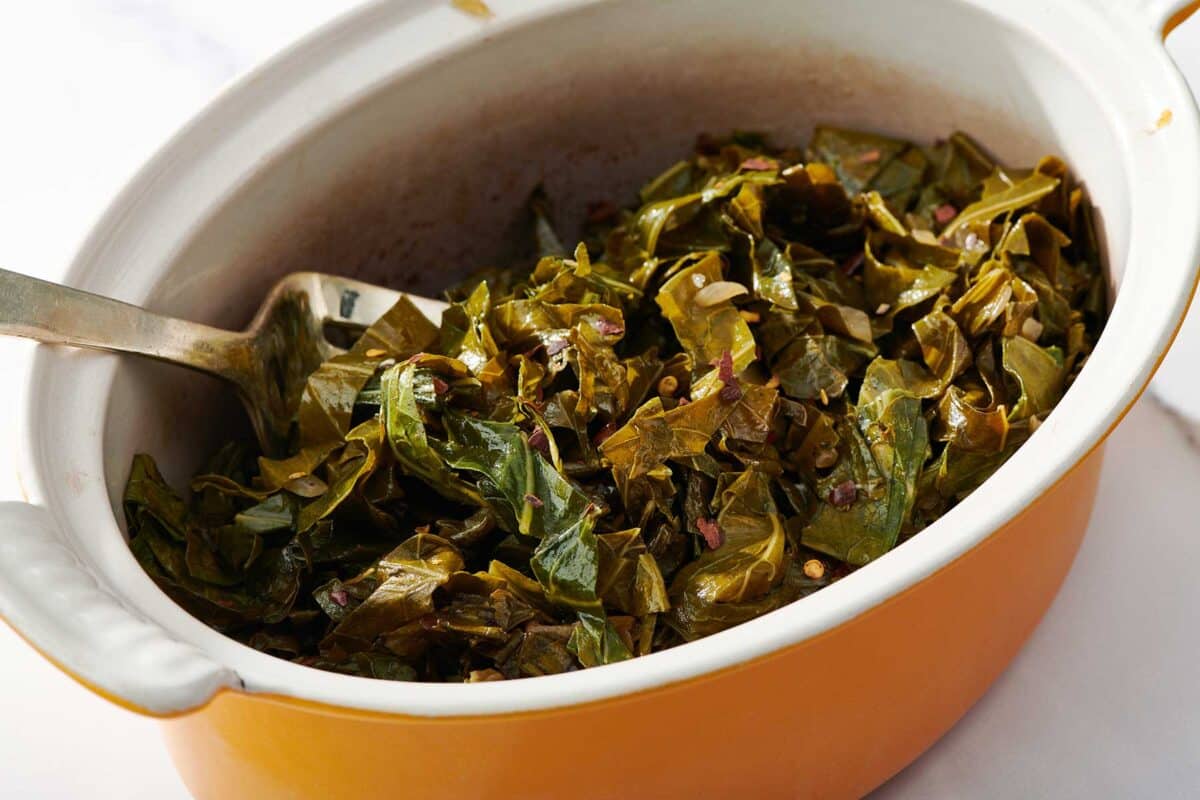
Vegetarians and vegans, rejoice! If you’ve had the experience of getting your hopes up about a mess o’ greens in a Southern restaurant or as part of a Southern spread, only to find out they were made with pork (as they often are in the South), this is the recipe for you. And beyond vegetarian, these are actually vegan as well! Serve these collard greens with Vegetarian Black Bean Soup or Grits and Cornbread for a true vegetarian Southern meal.
Also try Vegetarian Mustard Greens!
By signing up, you agree to our Privacy Policy.
What's In This Post?
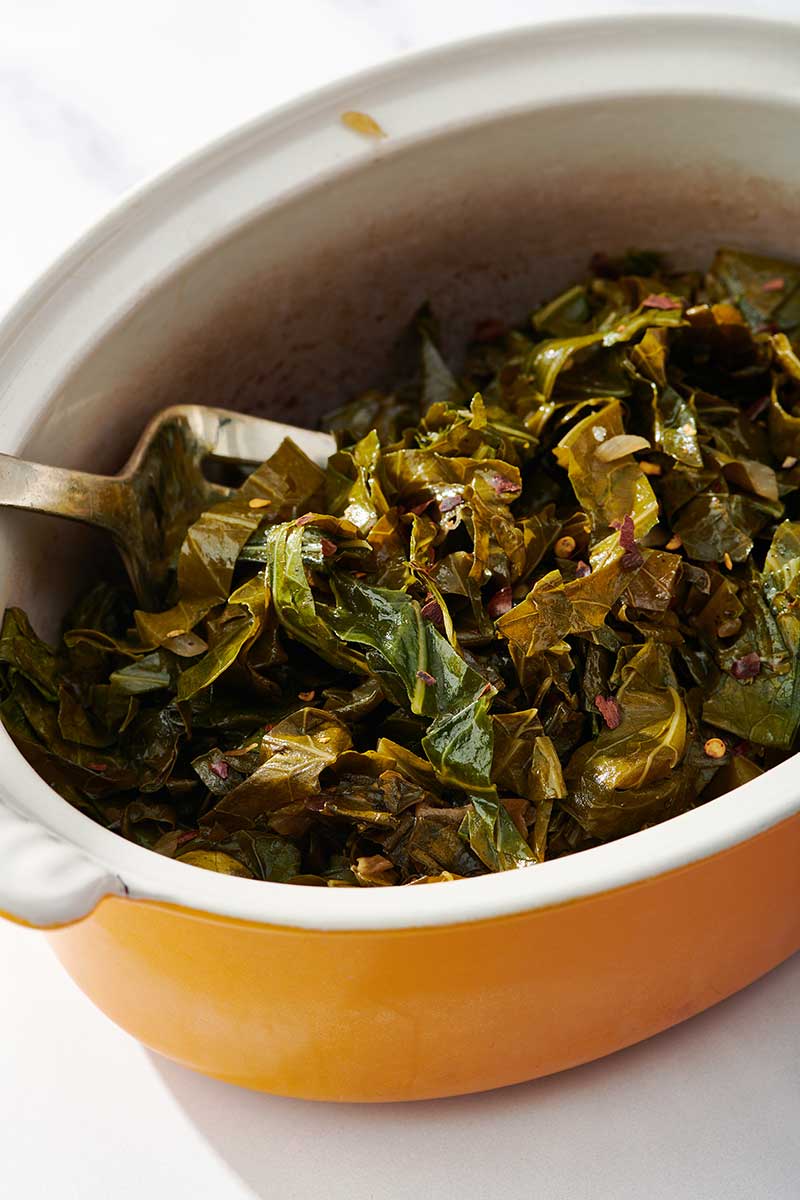
This Vegetarian/Vegan Collard Greens recipe is the classic Southern vegetable staple, but with no meat. Easy, healthy, and downright delicious.
Ingredients
- Vegetable or olive oil – The oil is used to sauté the aromatics, creating a flavorful base before adding the greens.
- Onion – White or yellow onions are most traditional in Southern cooking, but any onion is fine.
- Garlic – I like slicing the garlic thinly so that you can see the little slivers in the final dish and the slices mellow in potency as they are cooked.
- Collard greens – Wash well, remove the stems, and chop the leaves before using.
- Vegetable broth – It’s good to use a vegetable broth with lower sodium so you can control the salt content.
- Red pepper flakes – Add a nice spice and complexity to the dish. Feel free to increase the amount if you like spiciness.
- Apple cider vinegar – Adds a nice acidity that brightens and balances the earthiness of the greens.
Washing and Preparing Collard Greens
The first step in cooking collard greens — wash them thoroughly! You can’t make good collard greens if there is any dirt or grit left.
To clean collard greens, fill a very large bowl or a sparkling clean sink with cold water and dunk those greens. Swish them around with your hands vigorously, then remove them, pour out or drain the water, rinse the sink or the bowl, and repeat. Do this as many times as necessary to remove all of the dirt from the greens. The water should be totally clear with no grit on the bottom of the bowl or sink when you are done.
Removing the stems is optional, but they are hard to get really soft unless you truly cook the greens down to a fairly mushy state. You can do this in a couple of ways: one, hold the stem and kind of fold the leaf in half over the stem. Then, tear the stem up and away from the leaf. No worries if the leaf tears, too — you’re going to be slicing and cooking it, so that won’t matter at all. Or, fold the leaf over the stem and use a sharp knife to slice along the stem, freeing the leaf. Coarsely chop the leaves and save the stems for stock or toss or compost them.

How to Make Vegetarian Collard Greens
- Sauté the veggies: Heat the oil in a large, deep skillet over medium-high heat. Add the onions and stir for about 3 minutes, then add the garlic and stir for another 2 minutes. Add the greens, and cook, stirring occasionally, until they begin to wilt, about 5 minutes. Pour in the broth.
- Season and simmer: Add the red pepper flakes, season with salt and pepper, then bring the broth to a simmer. Lower the heat to medium and cover the pot. Cook, lifting the lid and stirring occasionally, for about 20 minutes, or until the collard greens are fairly tender but not super soft. (Or cook for more or less time! Your call!)
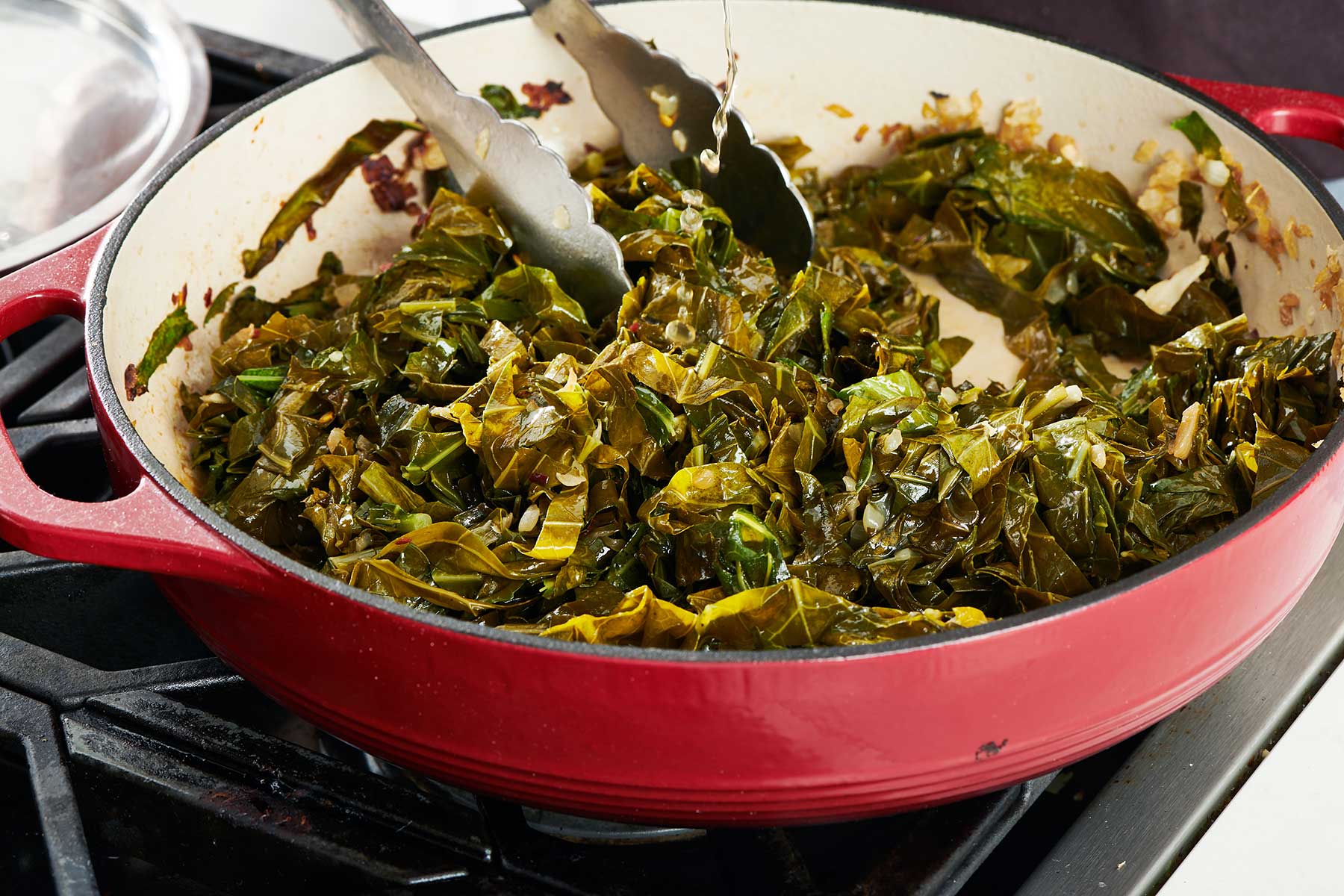
- Serve: Sprinkle the greens with the vinegar, stir to combine, and serve hot, spooning up some of the liquid (called pot-likker) to serve with the greens.

FAQs
It is up to you how soft you like your collard greens, but it is definitely possible to overcook them. I like to keep mine simmering for 20 minutes so that they get nice and tender while keeping their green color. Longer is fine, too, but overcooked collard greens will turn gray, become mushy, and even have an increased bitter flavor. Stop before that happens!
The best way to prevent bitterness in collard greens is to avoid overcooking them and to add an acidic element. The acid brightens up the flavor of the cooked greens and brings out their vibrant earthiness while toning down the bitter notes. I use apple cider vinegar because it has a nice sourness with a little bit of sweetness.
It is definitely better to braise collard greens than to boil them. Although the end result might look similar, boiling causes much of the nutrients and flavor to seep out of the greens and into the water. Braising the collard greens in a flavorful broth and serving them with the liquid ensures that you keep all that flavor and all of those nutrients!
How to Store Cooked Collard Greens
You can store these in a tightly covered container for up to 5 days in the fridge. Reheat gently with the pot-likker over medium-low heat until hot throughout, stirring frequently.
Cooked collards can also be frozen with their liquid. Place them, with some of the cooking juice (pot-likker), in freezer-proof zipper top bags, press out any additional air, and freeze for up to 6 months. Thaw overnight in the refrigerator or on the counter for a few hours before reheating.
What to Serve With Vegetarian Collard Greens

More Vegetarian Greens Recipes
- Sautéed Broccolini
- Beets and Sautéed Beet Greens
- Sautéed Kale
- Swiss Chard
- Sautéed Spinach
- Sautéed Broccoli Rabe
Pin this now to find it later
Pin It
Vegetarian Collard Greens
Ingredients
- 2 tablespoons vegetable or olive oil
- 1 small onion (finely chopped)
- 2 cloves garlic (very thinly sliced)
- 2 pounds collard greens (very well rinsed and coarsely chopped; see Note)
- ½ cup vegetable broth (preferably less-sodium)
- ¼ teaspoon red pepper flakes (or to taste)
- Salt and freshly ground black pepper (to taste)
- 2 teaspoons apple cider vinegar
Instructions
- Heat the oil in a large, deep skillet over medium-high heat. Add the onions and stir for about 3 minutes until they start to turn golden. Add the garlic and stir for another 2 minutes, until the garlic turns golden. Add the greens to the pot and stir to coat them with the oil and onions. Cook, stirring, occasionally until they begin to wilt, about 5 minutes. Pour in the broth. Add the red pepper flakes, season with salt and pepper, then bring the broth to a simmer. When the broth is simmering, lower the heat to medium and cover the pot. Cook, lifting the lid and stirring occasionally, for about 20 minutes, or until the collard greens are fairly tender but not super soft. (Or cook for more or less time! Your call!)
- Sprinkle the greens with the vinegar, stir to combine and serve hot, spooning up some of the liquid (pot-likker) to serve with the greens.
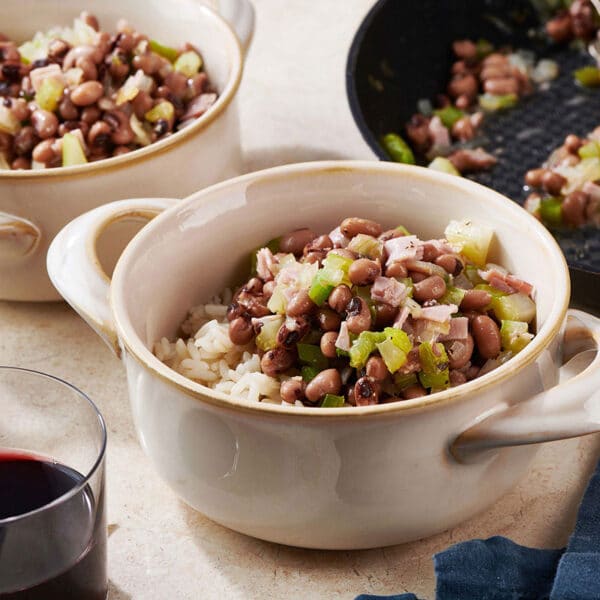
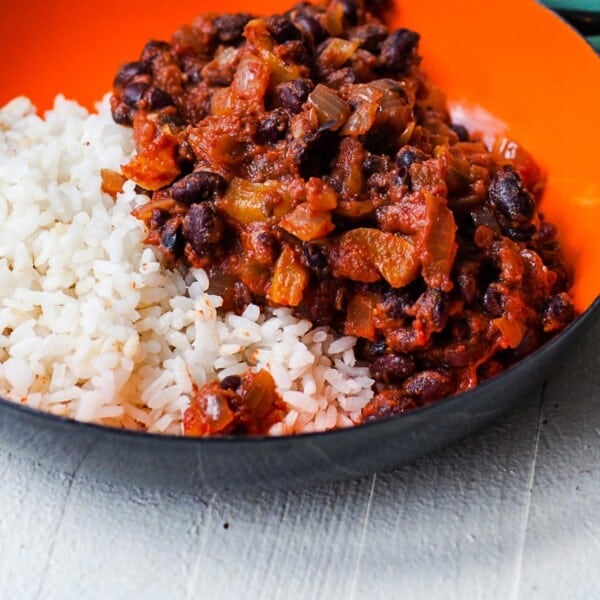

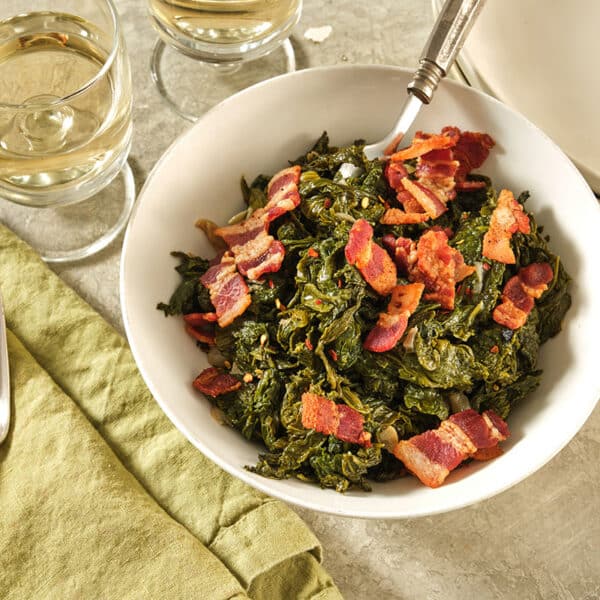
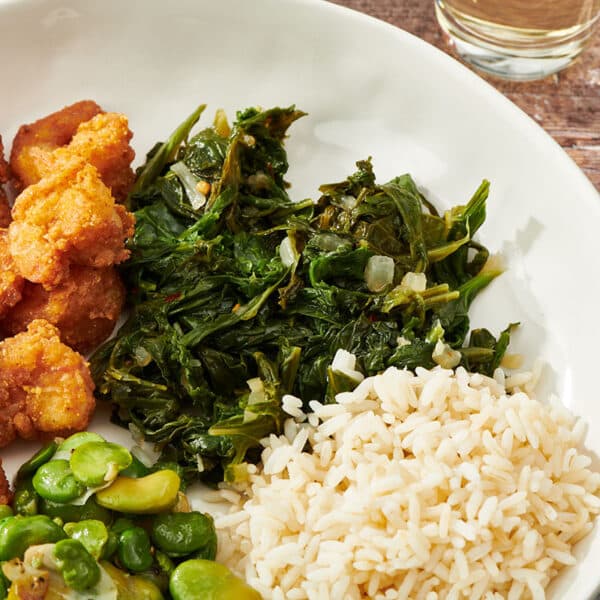
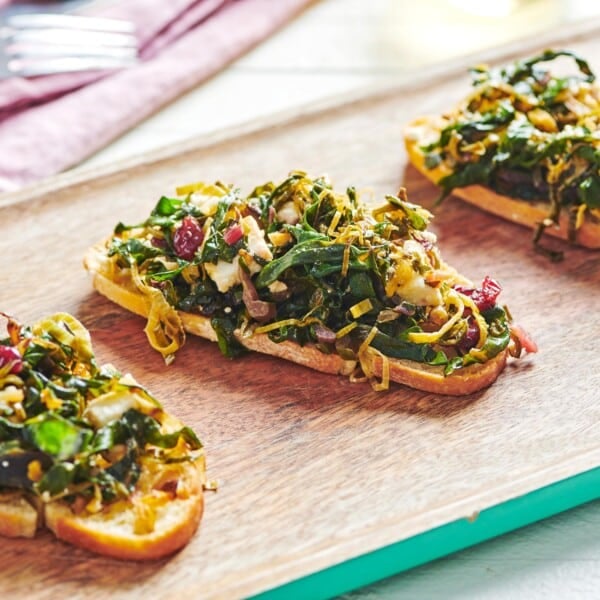
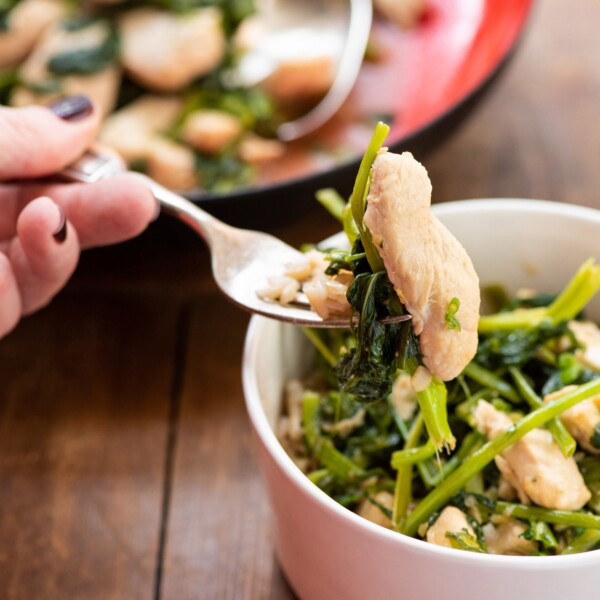









Can a meat-free version of a classic Southern dish like collard greens still capture the essence and flavor of the traditional recipe?